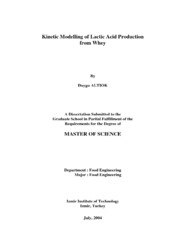Please use this identifier to cite or link to this item:
https://hdl.handle.net/11147/3267| Title: | Kinetic Modelling of Lactic Acid Production From Whey | Authors: | Altıok, Duygu | Advisors: | Tokatlı, Figen | Publisher: | Izmir Institute of Technology | Abstract: | Lactic acid is a natural organic acid, which is used in pharmaceuticals, chemical, textile and food industries. Since only L(+) lactic acid is found in normal human metabolism, the microbial production of L(+) lactic acid has great interest in recent years. Use of whey lactose to produce lactic acid by fermentation process is favourable due to the low cost of whey and its high organic matter content. Whey is suitable medium for some fermentations. However, its high lactose content makes it a potential environmental pollutant. The disposal problem of this pollutant could be overcome by utilization of whey lactose in the lactic acid production.The aim of this study was to develop a kinetic model for lactic acid productionfrom whey by Lactobacillus casei, which is a homofermentative lactic acid bacteria andcapable of producing L(+) lactic acid. Within this context, several batch fermentationexperiments in fermenter were performed at 37 C and pH 5.5. Seed culture that was produced in shake flask fermentations was used as the inoculum for the fermenter.Before the fermentation experiments, some of the proteins in whey were denatured by heat treatment and separated by centrifugation. This treatment decreased the protein amount from 11.15 % to 5.2 % in whey powder. The lactic acid production was associated with the biomass growth up to a certain time, but then a non-growth associated lactic acid production was observed in most of the fermentations except for the 9.0 g l-1 initial substrate fermentation run, where all the substrate was utilized when the stationary phase was attained. The maximum theoretical productivity was obtained as 2.4 g lactic acid l-1 h-1 in the fermentation with S0 equals to 35.5 g l-1. The kinetic parameters were obtained from different fermentation runs. mmax and KS were found as 0.265 h-1 and 0.72 g l-1, respectively. The average product yield coefficient, YPS, was determined as 0.682 g lactic acid (g lactose)-1.The modified form of logistic equation with product inhibition term for biomassThe modified form of logistic equation with product inhibition term for biomass growth, Luedeking and Piret equation for product formation and substrate utilization considering the consumption of substrate for product formation and maintenance, described most of the fermentation experiments in this study with high accuracy (SSE range was 0.0804-0.1531). The toxic powers in these inhibition terms, h and f, made the model applicable for the fermentation experiments with low and high initial substrate concentrations. In case of high initial substrate concentration fermentation (S0. 95.7 g l-1), the same model explains only the exponential phase of biomass and its product formation eventhough the substrate consumption is predicted very well.product formation eventhough the substrate consumption is predicted very well. | Description: | Thesis (Master)--Izmir Institute of Technology, Food Engineering, Izmir, 2004 Includes bibliographical references (leaves: 59) Text in English; Abstract: Turkish and English xii, 75 leaves |
URI: | http://hdl.handle.net/11147/3267 |
| Appears in Collections: | Master Degree / Yüksek Lisans Tezleri |
Files in This Item:
| File | Description | Size | Format | |
|---|---|---|---|---|
| T000471.pdf | MasterThesis | 959.32 kB | Adobe PDF |  View/Open |
CORE Recommender
Page view(s)
376
checked on May 5, 2025
Download(s)
552
checked on May 5, 2025
Google ScholarTM
Check
Items in GCRIS Repository are protected by copyright, with all rights reserved, unless otherwise indicated.